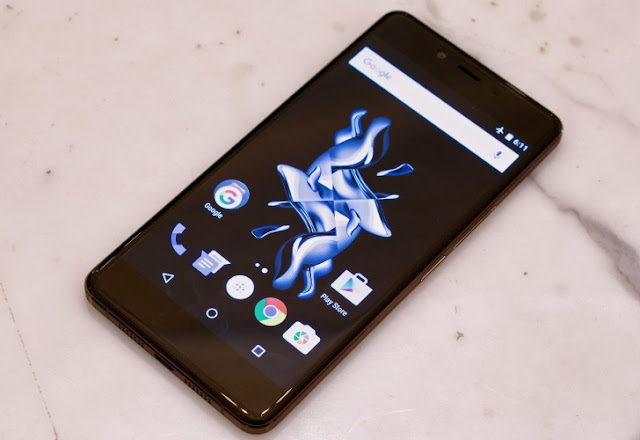Introduction
At a press conference held yesterday OnePlus presented their third
phone - the OnePlus X. The OnePlus X is a significant departure from the
Flagship Killer mantra that followed the past two models. This time,
OnePlus focused more on delivering a compact device that still retained a
good deal of features and specifications but wasn't really a flagship
device anymore.
Don't get us wrong, the OnePlus X is a capable device on its own just
as well. It's just that it's targeted at another market segment.
OnePlus has gone to great lengths to assure there is a premium feel
about the phone and their attention to detail (and marketing too) is
just as high as before.
OnePlus X at a glance:
- Body: Metal frame + glass/ceramic back
- Display: 5.0-inch, 1920x1080 resolution AMOLED
- Chipset: Qualcomm Snapdragon 801 with 2.3GHz quad-core CPU, Adreno 330 GPU and 3GB RAM
- Storage: 16GB, expandable via microSD card slot
- Camera: 13 megapixel ISOCELL rear camera, phase detection autofocus, single LED flash, 1080p video
- Secondary: 8 megapixel
- Connectivity: Dual SIM, LTE, Wi-Fi 802.11n, Bluetooth 4.0, GPS, microUSB
- Battery: 2525mAh
- OS: Oxygen OS 2.1.0 based on Android 5.1.1 Lollipop
OnePlus will be launching the OnePlus X in two variants. The mass
market version will be the more affordable Onyx Black variant with a
glass back, but there is also the Ceramic variant, which will not only
be available in limited markets but also in limited numbers. The Ceramic
version will be made available a bit later than the standard issue
black one (Nov 24) and for now it will be available only the EU and
India.



 OnePlus press shots in Onyx Black back
OnePlus press shots in Onyx Black back



 OnePlus press shots with Ceramic back
OnePlus press shots with Ceramic back
The OnePlus X will be launching on November 5 in the EU and India and on November 19 in the US.
We enjoyed our short time with it and here come our first impressions.
Design
Unlike the previous OnePlus devices where the focus was more or less
solely on the specifications and performance, with the OnePlus X the
company took a step back from creating a spec monster and focused more
on the design. It's clear with the OnePlus X that the design is the
biggest feature of the device.

Unlike the OnePlus One, which was entirely plastic and the OnePlus 2,
which was part metal and part plastic, the OnePlus X is a combination
of both metal and glass, making it seem even more premium than both of
its elder siblings.
The frame of the device is made out of anodized aluminum with 17
micro cuts running along the edges. The cuts are fine and give the sides
a serrated finish making them inherently grippy.
The front and back on the Onyx version are made out of glass with curved edges that flow gently into the metal sides.
On the Ceramic version, the back is made out of ceramic, which is
cast out of a zirconia mold and takes 25 days to make, which is why
OnePlus will only be making 10,000 of these. The Ceramic version has a
high gloss near-perfect mirror-like finish and even more pronounced
angled edges. While the process behind it is fascinating and the
material is significantly tougher than the glass used on the Onyx
material, in reality it is often hard to tell the two models apart,
especially in dimly lit indoor environments. This does make it somewhat
harder to justify the additional cost of the Ceramic version (it's extra
$110/€100/£69).
The front of the device has the 5.0-inch display in the center. Above
the display is the earpiece, front facing camera, the sensors, and a
tiny LED notification light at the top right.
Below the display are three practically invisible Home, Back, and Overview keys that aren't even backlit.
On the right are the power and volume control buttons with a nice damped feel, tight tolerances, and no unnecessary play.
 OnePlus X right side
OnePlus X right side
On the left is the wonderful slider from the OnePlus 2 with three
positions for the silent, priority notifications only, and all alerts
modes. The slider has a grippy pattern like the one on the OnePlus 2 and
it works great.
 OnePlus X left side
OnePlus X left side
On the top is the headphone jack and on the bottom are the microUSB
port, microphone, and a single loudspeaker. It would have been nice to
see the USB Type-C connector from the OnePlus 2 on the OnePlus X as
well.

 OnePlus X top and bottom
OnePlus X top and bottom
On the back, you find the 13 megapixel camera with single LED flash
sitting flush with the back giving it a perfectly flat appearance.
AMOLED displays quite frequently seem to have overdone color
saturation and a certain tint but OnePlus has done a decent job of
calibrating the 5-inch display that it doesn't seem to suffer from those
disadvantages.

The display also gets quite bright, although we couldn't see how it
looks under the sun. Viewing angles are decent and the 1080p resolution
is more than adequate for a 5.0-inch display. Overall, nothing
extraordinary, but for the price this is a pretty good screen.
The overall design of the OnePlus X is impressive and the phone looks
and feels premium. But more importantly, for some people, it no longer
feels ungainly to use and the compact dimensions make it perfectly
usable with one hand while maintaining a decent display size. This is
easily one of the most premium looking and feeling phone in its price
range, and feels even better than some of the more expensive phones.
Built around a once popular chipset
The OnePlus X runs on a Qualcomm Snapdragon 801 chipset, with 3GB of
LPDDR3 RAM and 16GB internal storage with microSD and USB OTG support.
On paper, this might not seem exciting but again, this isn't exactly a
flagship device.
The OnePlus X is actually quite impressive in terms of performance.
Snapdragon 801 might seem long in the tooth now but being an 800 series
chipset it still packs a punch and handily blows the Snapdragon 615,
seen on some of the rival devices, out of the water. The phone worked
smoothly and apps opened, closed, and switched quickly. The overall
performance during our quick hands-on was definitely impressive and
assuming it is able to maintain that over a period it shouldn't be a
cause for concern to anyone.




 Oxygen OS 2.1 on the OnePlus X
Oxygen OS 2.1 on the OnePlus X
On the software side, the OnePlus X runs on Oxygen OS 2.1 based on
Android 5.1.1 Lollipop. The software is more or less identical to that
on the OnePlus 2 (there is a new FM Radio app), which in theory should
be a good thing but considering OnePlus 2 still has plenty of bugs to
iron out, we'd hope the OnePlus X is more polished than its elder
sibling.




 Oxygen OS 2.1 on the OnePlus X
Oxygen OS 2.1 on the OnePlus X
The OnePlus X is also a dual SIM phone, although the second SIM slot
is shared with the microSD, so you can either have a second SIM or a
microSD but not both. You're bound to have a microSD in as there is only
16GB of internal space so we'd guess few people would use it for its
Dual SIM functionality. In terms of other connectivity features there's
the usual LTE, Wi-Fi, Bluetooth, and GPS but once again, there is no NFC
like on the OnePlus 2.
Camera
The OnePlus X has a 13 megapixel ISOCELL camera on the back with f2.2
aperture and hyrid phase detection autofocus. It can also record 1080p
video, which seems like a deliberate cutdown considering the chipset
does support 4K on other devices, such as the Xiaomi Mi 4. The front
camera has a resolution of 8 megapixels with fixed focus and f2.4
aperture.
The image quality can vaguely be described as
good. We could
only test it indoors in poor lighting conditions. Considering the odds
were stacked against it, we'd say the camera fared well and despite the
lighting, the images are usable with good amount of detail and
acceptable amount of noise. We'd like to test it more thoroughly in
different lighting conditions but from our brief experience with it we
are willing to bet the overall image quality is going to be pretty good.

 HDR mode: Off • On
HDR mode: Off • On
The camera speed is also impressive. The camera launches and shoots
quickly. The phase detection autofocus occasionally falters but is still
quick even in low light.
The camera software is similar to the one on the OnePlus 2, which
means it's really not very good. It follows the Google Camera app too
closely, which honestly is far from user-friendly. There aren't many
shooting options available and the app makes you feel like a novice who
has just figured out how to take a picture. Those who want more control
are bound to be left frustrated.
The camera app doesn't have any quick launch gesture by default but
you can assign any of the capacitive buttons below the display to launch
the camera by double tapping, but this only works if the phone is
unlocked.
Wrapping it up
OnePlus wasn't keen on letting people spend too much time with the
devices and we wish we could have tried a few more things, but then
again, that's what the full review is for. From what we gather from this
brief hands-on, the OnePlus X is a very solid contender for the best
mid-range smartphone of the year.
At $249/€269/£199 for the Onyx Black version, OnePlus has once again
set the bar with the pricing, and from what we could tell, there doesn't
seem to have been any compromises made to reach that point. The OnePlus
X has good design, good display, and good performance. In the end, the
catch will always remain OnePlus' frustrating invite system and the
lackluster after sales support. Not to mention the software issues that
will invariably crop up due to the company's lack of experience in the
field. Is the phone really worth dealing with all that, is something we
will find out only after a full review.
Source: gsmarena.com




.jpg)









.jpg)

